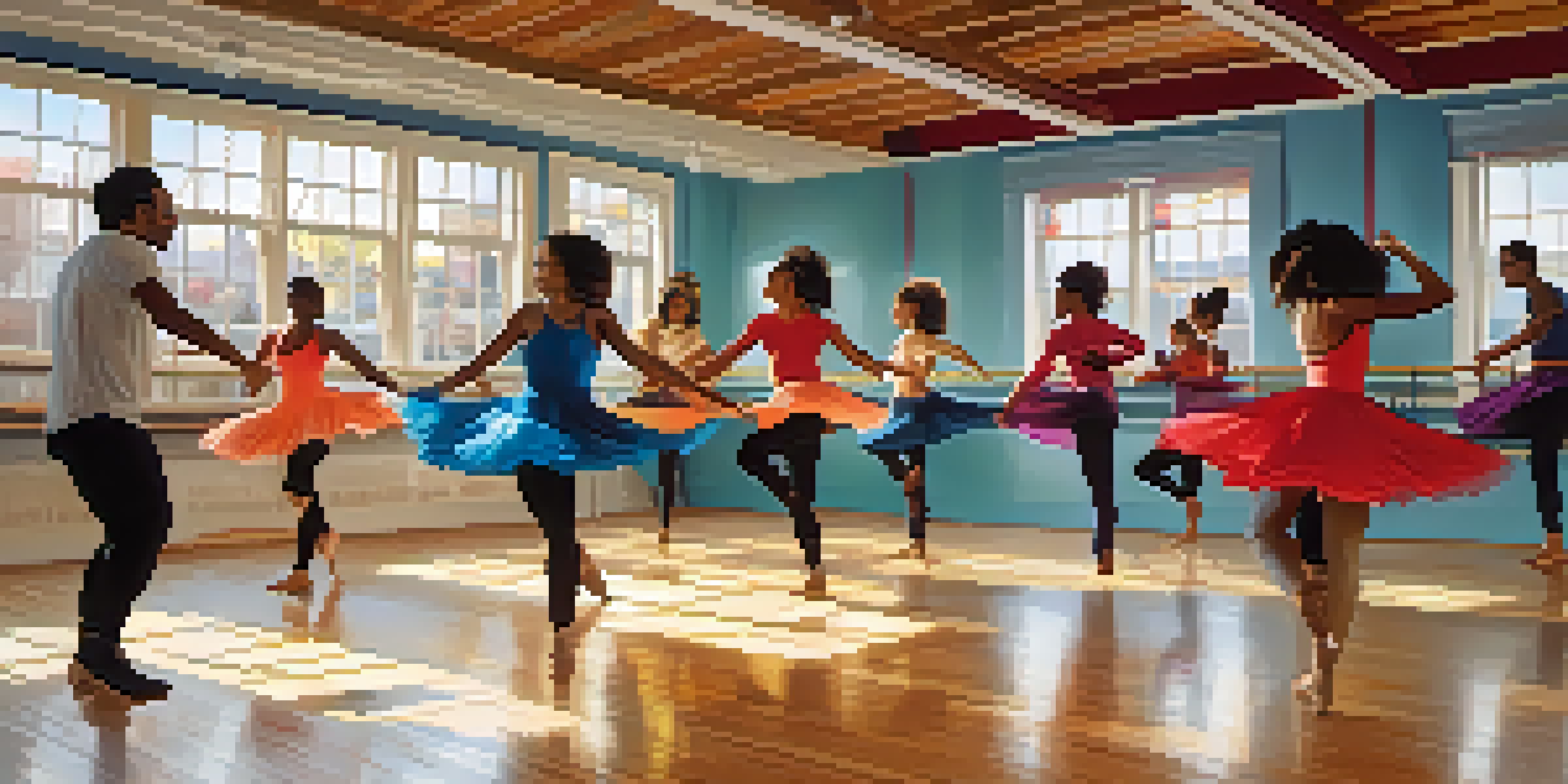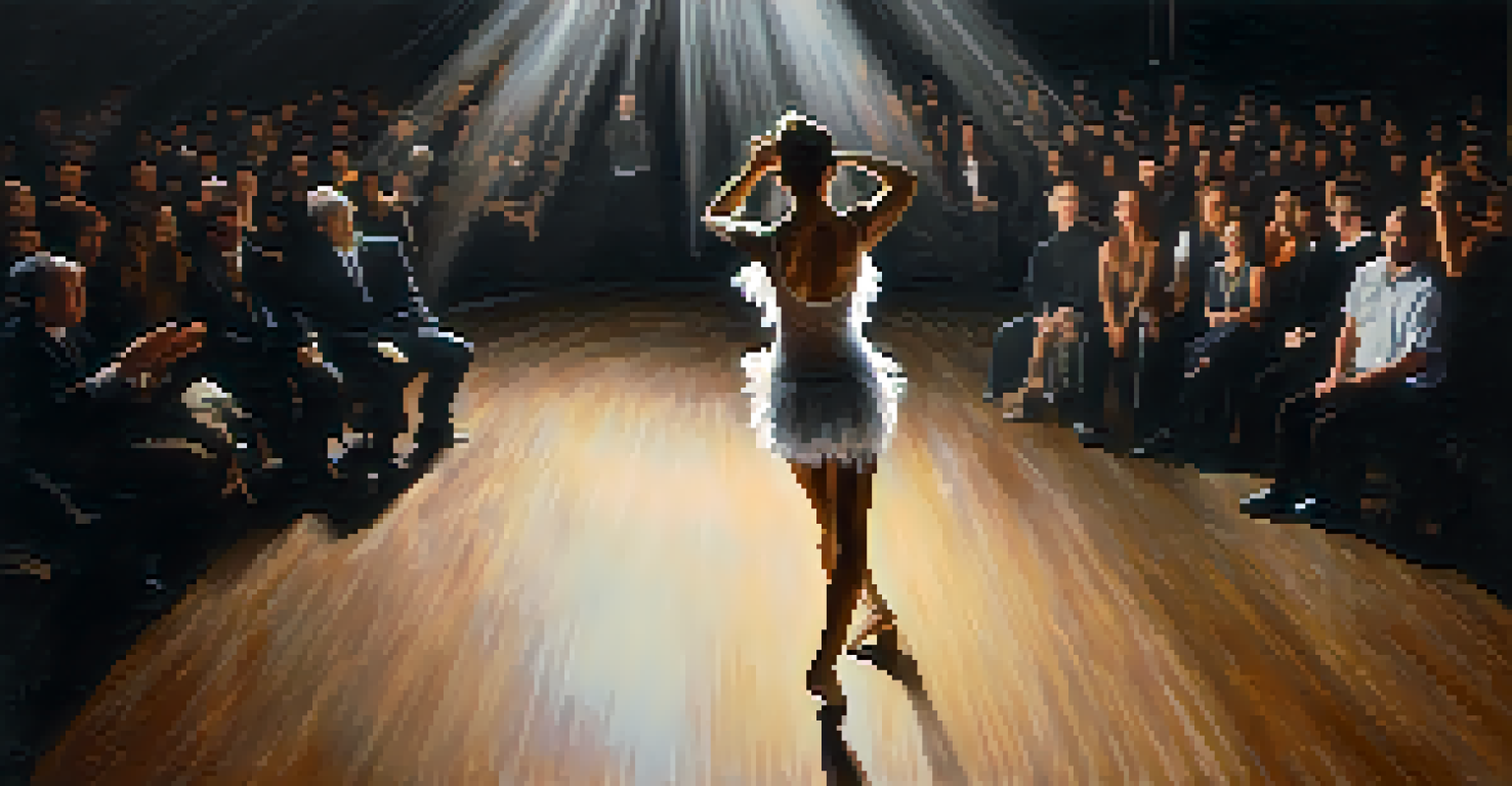The Role of Improvisation in Choreographic Composition

Understanding Improvisation in Dance Composition
Improvisation in dance refers to the spontaneous creation of movement without pre-planning. It's like jamming in music, where dancers respond to their instincts, the music, or each other in real-time. This freedom allows for a unique expression that can lead to unexpected discoveries in choreography. Dancers often find that improvisation opens up new pathways for creativity that structured rehearsals might overlook.
Improvisation is the ability to create and respond in the moment, allowing for a unique expression of artistry.
In the world of dance, improvisation serves as a vital tool for choreographers, acting as a playground for experimentation. It encourages dancers to explore their physicality and emotional depth, often leading to richer performances. For example, a choreographer might start with a loose theme and then let dancers improvise their movements, which can inspire new ideas for the final composition. This process highlights the organic nature of dance as an art form.
Moreover, improvisation fosters collaboration among dancers, creating a shared space where ideas can blossom. When dancers feel free to explore, they often contribute unique movements and concepts that enhance the overall work. This collaborative spirit not only enriches the choreography but also builds a sense of community within the dance company, making improvisation an essential aspect of the choreographic process.
The Benefits of Incorporating Improvisation
Incorporating improvisation into choreography can significantly enhance a dancer's creativity. When dancers engage in improvisational exercises, they learn to trust their instincts and develop a more profound connection with their body. This practice can lead to innovative movement patterns that infuse fresh energy into choreographed pieces. Just as a painter experiments with colors on a canvas, dancers can experiment with movements to discover new artistic expressions.

Improvisation also plays a crucial role in developing a dancer's adaptability. In performance settings, unexpected situations can arise, and having a strong improvisational skill set allows dancers to respond fluidly. This adaptability can be likened to a seasoned actor who can think on their feet during a live performance. As a result, dancers become more versatile performers, capable of handling whatever comes their way.
Improvisation Sparks Creativity
Engaging in improvisation helps dancers discover innovative movements and fosters a deeper connection with their bodies.
Additionally, engaging in improvisation can help reduce performance anxiety. When dancers focus on the freedom of creation rather than the pressure of perfection, they often find themselves more relaxed on stage. This shift in mindset can lead to more authentic and captivating performances, as the dancers are less concerned about executing every move flawlessly and more focused on expressing themselves through movement.
Improvisation as a Tool for Choreographic Development
Choreographers often utilize improvisation as a foundational tool in the developmental stages of a piece. By allowing dancers to explore freely, choreographers can identify compelling movements or themes that resonate with the group's energy. This organic approach can reveal insights that might not emerge in a more rigid choreographic process. Essentially, improvisation acts as a catalyst for innovation, sparking ideas that lay the groundwork for the final performance.
In every performance, the dancer must find the balance between structure and freedom, allowing the spirit of improvisation to shine.
Moreover, the improvisational process can lead to a more cohesive work as dancers contribute to the piece's narrative and emotional arc. When they have a hand in shaping the choreography, the final product often feels more authentic and genuine. Think of it as a collaborative writing session, where each writer adds their voice to create a rich and layered story. This collaborative input can transform a choreographic vision into a collective experience that resonates with audiences.
Improvisation can also help in refining movements during the rehearsal process. As dancers play with different interpretations, choreographers can gather feedback and make adjustments to enhance the overall piece. This continuous cycle of creation and refinement can ensure that the choreography remains dynamic and relevant, much like how a sculptor might carve away at a block of stone to reveal the masterpiece within.
Cultivating a Safe Space for Improvisation
Creating a safe environment for improvisation is crucial for fostering creativity among dancers. When dancers feel secure and supported, they are more likely to take risks and express themselves authentically. A safe space can be achieved through open communication and encouraging feedback within the dance community. Just as a nurturing classroom setting allows students to flourish, a supportive dance environment enables improvisation to thrive.
In addition to emotional support, physical space is also vital for improvisation. Dancers need room to experiment and move freely without the fear of bumping into one another or restricting their movements. A spacious studio can be compared to a blank canvas, inviting creativity to unfold. When dancers can fully explore their range of motion, the potential for innovative choreography expands exponentially.
Collaboration Enhances Choreography
Improvisation encourages dancers to contribute unique ideas, enriching the overall choreography and building community.
Furthermore, establishing clear guidelines for improvisation can help maintain a productive atmosphere. By setting boundaries while still allowing freedom, dancers can feel both secure and inspired to explore. It’s similar to giving a child creative materials but within the context of a project; they can play while still having a framework. This balance encourages dancers to push their limits while ensuring that the improvisational process remains focused and purposeful.
Improvisation in Rehearsal: Enhancing the Process
Incorporating improvisation into rehearsals can significantly enhance the overall creative process. When dancers are encouraged to explore movement organically, it often leads to breakthroughs that can energize the entire rehearsal. This approach can be refreshing, breaking the monotony of repetitively practicing set choreography. Just like a breath of fresh air invigorates the mind, improvisation can rejuvenate the rehearsal atmosphere.
Additionally, using improvisation within rehearsals allows for more personalized expression. Dancers can infuse their unique styles and emotions into the choreography, creating a diverse tapestry of movement. This personalized touch can make the piece more relatable to audiences, as they sense the genuine emotions behind the performance. Think of it as a band where each musician brings their flavor to the song, creating a richer sound.
Moreover, improvisation can serve as a powerful tool for addressing potential challenges in the choreography. If a particular movement feels forced or unnatural, dancers can improvise alternatives that feel more comfortable. This adaptability can lead to a more polished final performance, as the piece evolves from a collaborative exploration rather than a strict adherence to the original structure. This process mirrors how a chef might adapt a recipe based on available ingredients, ensuring the dish remains delightful and satisfying.
The Relationship Between Improvisation and Performance
The relationship between improvisation and performance can be quite profound. When dancers integrate improvisational elements into their performances, they can create a sense of spontaneity that captivates audiences. This unpredictability is akin to the thrill of a live concert, where the energy of the moment influences the performance. Audiences are often drawn to authenticity, and improvisation allows dancers to connect with their emotions in real-time.
Furthermore, improvisation can lead to memorable and unique performances that stand out. Each show can become a distinct experience, as dancers respond to the audience and the atmosphere of the venue. This aspect of performance can transform a routine into an unforgettable event. Just as a storyteller might change their delivery based on audience reactions, dancers can adapt their movements to enhance the overall experience.
Balancing Structure and Freedom
Choreographers must carefully balance spontaneity and structure to maximize the benefits of improvisation while maintaining cohesion.
In essence, the improvisational aspect of performance brings a layer of excitement and unpredictability. Dancers can take risks and explore new interpretations, which can lead to moments of pure magic on stage. This improvisational spirit not only enriches the performance but also resonates with audiences, fostering a deeper appreciation for the art of dance.
Challenges and Considerations in Using Improvisation
While improvisation offers many benefits in choreography, it also presents certain challenges. One of the primary concerns is maintaining a balance between structure and spontaneity. Too much freedom can lead to chaos, while too much structure can stifle creativity. Choreographers must find a way to guide the improvisational process while allowing dancers the freedom to explore. It’s a bit like walking a tightrope; both balance and risk are essential for success.
Additionally, not all dancers may feel comfortable with improvisation. Some may prefer the security of set choreography, while others might thrive in an open environment. Choreographers must be mindful of their dancers' varying comfort levels and provide appropriate support and encouragement. It’s similar to a team sport where each player has a different role; understanding these dynamics is crucial for a harmonious collaboration.

Lastly, the integration of improvisation into choreography requires time and patience. Developing a culture of improvisation may take time, as dancers learn to trust themselves and each other. Just as a plant needs time to grow, so too does a dancer’s ability to improvise flourish with consistent practice and support. By nurturing this growth, choreographers can create a vibrant environment that celebrates creativity and innovation.